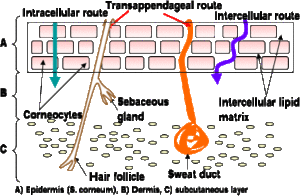It is often asked do cosmetic ingredients penetrate the skin or is it just a marketing ploy to get you to spend more money. If they do penetrate, am I going to get the benefits that the scientist in the laboratory get in their studies. There is so much misconceptions, myths and lies about what can and cannot get into your skin. In this blog we look at the conditions that need to be present for an ingredient to penetrate into the skin to deliver the benefits of healthy glowing skin.
Lies, myths and misconceptions of how ingredients penetrate.
There are many companies and products to taut the benefits of their products and of the active ingredients. They will cite many studies to help boast their claims but you need to be a lawyer or scientists to be really able to decipher the truth from the lies eg stem cell ingredients to make you younger.
Read: Do products really contain stem cells?
Then you have the scare campaigns that have their own agenda and reason to stop you using a product or ingredient. We seen it on Dr Oz and multiple other TV, advertisement and websites – “women absorb “X” amount of cosmetics each year – leading to breast cancer etc, etc” or “Vaseline is absorbed by the skin”. In the article by Natalie Bell she calculates the true amount of lipstick that you may eat of your lips and debunks the horror headlines that women are eating themselves into illness due to lipstick wearing.
Read: Beauty Myth Busting: Do Women Actually Eat 7 Pounds of Lipstick in Their Lifetimes? by Natalie Bell (
It is because of these two reasons I wanted to set the record straight on how ingredients penetrate the skin so that you can make an educated decision and purchase of cosmetics especially products with active ingredients. There are several conditions that must be present to allow ingredients to be absorbed through the skin. I will try to keep it as simple as possible so that you are not bogged down with high scientific jargon. Please note I am not discussing ingredients that can be absorbed by the skin and then into the bloodstream. These are pharmaceutical products and not cosmetics which has to be tested and approved for safe use.

Firstly one of the skins jobs is to protect the insides of our body from the outside elements thus it is setup in a very sophisticated way to prevent the outside getting into the body and it dose this via a complex layering systems. Epidermis the outer layer of our skin prior to the dermis and Hypodermis and has a pH is 4.5-5.5 and made up of several sub-layers. The most outer layer of the Epidermis is call the stratum corneum (though technically dead) and with its brick wall structure prevents the majority of the absorption of ingredients. The other sub-layers and layers of the skin all set up barriers and receptors to be able to absorb or reject ingredients too. There are 3 physical routes in which ingredients can penetrate is Epidermis. They are the intracellular, Intercellular route and the Transappendageal route via the hair and sweat ducts.
Size/molecular weight control skin penetration
To enable ingredients transport through these various routes they must meet the following criteria. The most obvious criteria is the size of the molecule of the ingredient. The molecule size must be smaller than 500 Daltons to penetrate the skin. A Dalton is the standard unit that is used measure the mass on an atomic or molecular. It is important to note that common allergens’ (like perfumes) that can cause irritation to the skin is less than 500 Daltons. Most molecules are simply too large to penetrate. For example Vaseline sits on the skin but never penetrates due to its large molecule size. Water molecules are too large to be absorbed into the skin. This is why when we go for a swim or bath we do not swell up like a sponge.
Read: Debunking the myth of Vaseline.
Whether the ingredient is Oil Soluble or Water Soluble
As pointed out in the above criteria our skin does not allow for water to be absorbed into the skin therefore in general, oil soluble ingredients penetrate the skin far more easier than water-soluble ingredients. In scientific terms we describe this as the hydrophile (water lovers) or lipophile (oil lovers). As the lipid (oil) that fills the space between the cells of the epidermis is an oily substance and thus it will be attracted to lipophilic ingredients and reject the hydrophilic ingredients.
What Electrical Charge/Polarity the ingredient carry.
This is a highly complex and scientific criteria but to keep it simple all molecules have a certain charge and it can be either a positive, negative or no charge at all. As a cosmetic chemist it does play an important role in formulating a product and how well an active ingredient will be absorbed and used by the skin cells. At most part you will not know what the polarity of the ingredient is unless you are told by the manufacture or reading it in a scientific study. It will not be listed on the product bottle. It is simply to say that a good formulator has taken this into account to ensure that the ingredients will penetrate the skin correctly
The condition of the skin will affect the ingredient penetrate.
Depending on area of the skin will determine the thickness of the skin. For example the skin around your eye is very thin where as the thickness of the skin on the palms of your hands is very thick. The thinner the skin the more easily it can allow for penetration. This is why exfoliation is great as it lifts and removes several small layers of the stratum corneum thus allowing for better penetration of your active ingredients. But remember there is a healthy limited to how much exfoliation that you can do to the skin before you damage the skin and affect the acid mantel.
Read: How much is too much exfoliation.
The temperature of the skin will also affect the ability of the ingredient penetration. The warmer the skin is the “more liquid” the lipids between the cells will be e.g. if you leave butter out of the fridge it is easier to spread and if you put it on a burner it will melt completely. This is why with most facials they will heat the skin via massage, steam or hot towels to help warm up the skin and allow for better absorption of the products.
The Acid mantel of the skin will hamper the ingredient penetration flow. Normal skin Acid mantel has a pH of 4.5 to 5.5 but when it is outside this range it can cause many skin problems and irritations but it will also affect the skin ability to absorb normal active ingredients. Many people with Acne, psoriasis and other skin diseases have poor acid mantel.
Age, Sex and Race even though age has been found to show a drying and thinning of the skin increases as you age and the acid mantel changes in you late 70’s on-wards it has not been shown that there is any influence on the skins ability to absorb ingredients. In a study it show that hydrophilic ingredients penetration was not influence by the sex or race of the skin.
Best topical delivery system of these active ingredients.
There are two reasons for wanting the ingredients to penetrate to the skin cells, one is to feed and the other is to medicate the skin. So if you have an active ingredient that is small enough, at the correct polarity, etc as discussed above it needs to be in the correct formula to enable the ingredient to be delivered. It is no use having the perfect ingredient but it is bound up in a formula that does not allow it to flow to the skin. Plus products need time to work and allow for ingredients to flow into the skin therefore all cleansers and rinse off products do not allow time for the ingredient to flow.So you want the active ingredients in a leave on product like toners, serums or moisturizers as this allow the skin time to allow for the flow of the ingredients.
Read: Cleanser are for cleaning and not for feed.
The product can also use of other ingredients in the skincare product that enhance the ability of skin penetration. For example a water soluble (hydrophilic) vitamin is encapsulated in an oil (avocado oil derivative) that allows the vitamin that would normal not be able to penetrate the epidermis to penetrate and be delivered to the cells that need the vitamin. There are several types of “penetration enhancers” either oily materials or ingredients with polyol (OH) groups which affect how the lipids between the stratum corneum works. Two great natural penetration enhancers is jojoba oil and peppermint oil. These penetration enhances are regulated by a variety of authorities depending on the country to ensure their safe usage levels.
To simplify what product will give you the best delivery of Active Ingredients
Oil base serums are the ultimate delivery product and second is a Water in Oil formulated toners, moisturizers and serums. The problem is that these types of formulas is that they are expensive. Good oil cost far more than water plus the production cost manufacturing water in oil products is very high and difficult. With Zen de Jour skincare all our vitamins are encapsulated so even in out moisturizers these special ingredients can be delivered to the cells that need them. All peptides are in a Water in Oil Formulation to ensure that the peptides can be do their magic.
Read: The results of using Zen de Jour Hair and Eyelash Growth Serum
♠♣♥♦♠♣♥♦♠♣♥♦♠♣♥♦♠♣♥♦♠♣♥♦♠♣♥♦♠♣♥♦♠♣♥♦♠♣♥♦♠♣♥♦♠♣♥♦♠♣♥♦♠♣♥♦♠♣♥♦
QUESTION ABOUT YOUR SKIN? Make an Appointment Today or send me an email to debra@debraspence.com
PERMISSION TO REPRINT: You may use any items from this article in your print, blog, magazine or electronic newsletter. But in order to do so, you must include the following paragraph “Information courtesy from Debra Spence – Answering your skin problems with Science and Nature. Debra Spence is a Cosmetic Chemist and Skin Specialist that provides skincare and treatment tips, products recommendation and reviews to professional and patients.” and included a link to www.debraspence.com.
Content Copyright © 2016, Debra Spence








